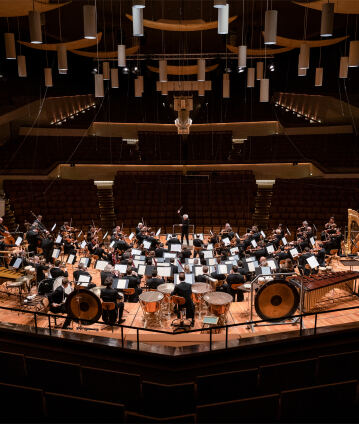Simon Rattle conducts Berio and Bartók

To help contain the coronavirus, the Philharmonie has been closed since 11 March. A last concert under the direction of Simon Rattle could still be given – but without an audience in the auditorium, exclusively and free of charge for visitors of the Digital Concert Hall. It opened with Luciano Berio’s Sinfonia, which plays creatively with sounds, noises and language. The highlight of the programme is Béla Bartók’s Concerto for Orchestra, which shifts between melancholy and vigorous rebellion.
Enigmatic, experimental, revolutionary – Luciano Berio’s Sinfonia for eight voices and orchestra is a milestone of new music. Commissioned for the New York Philharmonic’s 125th birthday and premiered in 1968 with the composer conducting, it combines very different musical ideas and aspects as in a kaleidoscope: it is analytical and sensuous at the same time, quotes European music history from Beethoven to Stockhausen, and seismographically mirrors social sensitivities of the 1960s. Berio used the eight voices, executed here by the Neue Vocalsolisten Stuttgart, in an entirely new way; he has them not only sing but also speak, whisper, shout and murmur. In the process he uses texts by Claude Lévi-Strauss and Samuel Beckett, as well as the name of Martin Luther King, who was assassinated in 1968. It is not the texts’ messages that are of primary importance: “The varying degree of perceptibility of the text is a part of the musical structure”, the composer stresses. Another important element of his Sinfonia is the Scherzo from Gustav Mahler’s Second Symphony that – Berio has written – is comparable to a river “going through a constantly changing landscape, sometimes going underground and emerging in another, altogether different place”.
Béla Bartók’s Concerto for Orchestra is also characterised by stylistic variety and musical heterogeneity. Bartók composed the work as a commission from the Koussevitzky Foundation in 1943 in American exile, already critically ill and in financial distress. And yet it is an homage to life: “The general mood of the work represents, apart from the jesting second movement, a gradual transition from the sternness of the first movement and the lugubrious death-song of the third, to the life-assertion of the last one”, the composer declared. Even the name of the piece seems like an anachronism, but Bartók explains it to mean that the individual orchestral instruments are treated in a concertant or soloistic manner in the course of this symphony-like orchestral work. Typical for Bartók’s tonal language is grappling with Hungarian and Southeast European folk music, which decisively shaped the rhythms, melodies and harmonies of his works – as they did his Concerto for Orchestra, which became of the composer’s most frequently played pieces. Sir Simon Rattle will conduct the Berliner Philharmoniker: after a classical and late Romantic programme, his second performance this season will be with these two 20th-century masterpieces.
© 2020 Berlin Phil Media GmbH
Related interviews
Artists
Our recommendations
- Dance project: “Swing Symphony”
- Season opening 2011: Simon Rattle conducts Mahler’s Seventh Symphony
- First concert in the Brahms/Schumann cycle with Simon Rattle
- Simon Rattle conducts “Noye’s Fludde”
- Simon Rattle conducts Tippett’s “A Child of Our Time”
- 2016 New Year’s Eve Concert with Simon Rattle and Daniil Trifonov